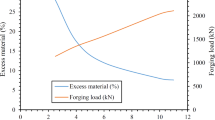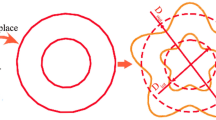Abstract
Filament wound composite pressure vessels are widely used in industrial applications. Determination of the optimal head profile has been recognized as one of the most important design issues. This paper presents the optimum design of head contours for a filament wound composite pressure vessel using a hybrid model of finite element analysis and inertia weight particle swarm algorithm. Geometrical limitations, winding conditions and the Tsai-Wu failure criterion have been used as optimization constraints. The objective is to maximize the shape factor using present optimization technique. An actual design example taken from available literature is used as a case study. Results indicate that the dome contours using the suggested method shows stronger structure and greater internal volume. This confirms that the proposed model can efficiently define the optimal dome shape.















Similar content being viewed by others
References
Hofeditz JT (1963). Structural design consideration for glass pressure vessels. 18th Annual Meeting of the reinforced Plastic Division
Young MH, Lloyd BA (1985). Rocket case performance optimization. 17th National SAMPE Technical conference
Fukunaga H, Chou TW (1988) Simplified design techniques for laminated cylindrical pressure vessels under stiffness and strength constraints. J Compos Mater 22:1156–69
Divita G, Marchetti M, Moroni P, Perugini P (1992) Designing complex-shape filament-wound structures. J Compos Manufact 3:53–8
Adali S, Summers EB, Verijenko VE (1993) Optimization of laminated cylindrical pressure vessels under strength criterion. J Compos Struct 25:305–12
Hojjati M, Safavi AV, Hoa SV (1995). Design of dome for polymeric composite pressure vessels. J Compos Eng 51–9
Liang CC, Chen HW, Wang CH (2002) Optimum design of dome contour for filament wound composite pressure vessels based on a shape factor. J Compos Struct 58:469–82
Vafaeesefat A, Khani A (2007) Head shape and winding angle optimization of composite pressure vessel based on a multi level strategy. J Appl Compos 14:371–79
Zu L, Koussios S, Beukers A (2010) Shape optimization of filament wound articulated pressure vessels based on non-geodesic trajectories. J Compos Struct 92:339–46
Paknahad A, Hojjati MH, Fathi A (2011).Dome design of composite pressure vessels using particle swarm optimization algorithm. 23th Canadian Congress of Applied Mechanics
Paknahad A, Nourani R (2014) Mix model of FE method and IPSO algorithm for dome shape optimization of articulated pressure vessels considering the effect of non-geodesic trajectories. J Inst Eng India Ser C 95(2):151–158
Reddy JN (2004) Mechanics of laminated composite plates and shells, theory and analysis, 2nd edn. CRC Press LLC, Boca Raton
Tsai SW, Wu EM (1971) A general theory of strength for anisotropic materials. J Compos Master 5:58–80
Vasiliev VV (2009). Composite pressure vessels: analysis, disugn and manufacturing. Bull Ridge Corporation
Park JS, Hong CS, Kim CG, Kim CU (2002) Analysis of filament wound composite structures considering the change of winding angle through the thickness direction. J Compos Struct 55:63–71
Kennedy J, Eberhart RC (1995). Particle swarm optimization. IEEE International Conference. on Neural Networks. 1942–48
Shi Y, Eberhart RC (1998). A modified particle swarm optimizer. IEEE Congress on Evolutionary computation 69–73
Acknowledgment
The Authors appreciatively acknowledge Prof. Mohammad Hassan Hojjati for his useful and precious comments.
Author information
Authors and Affiliations
Corresponding author
Rights and permissions
About this article
Cite this article
Paknahad, A., Fathi, A., Goudarzi, A.M. et al. Optimum head design of filament wound composite pressure vessels using a hybrid model of FE analysis and inertia weight PSO algorithm. Int J Mater Form 9, 49–57 (2016). https://doi.org/10.1007/s12289-014-1199-2
Received:
Accepted:
Published:
Issue Date:
DOI: https://doi.org/10.1007/s12289-014-1199-2




